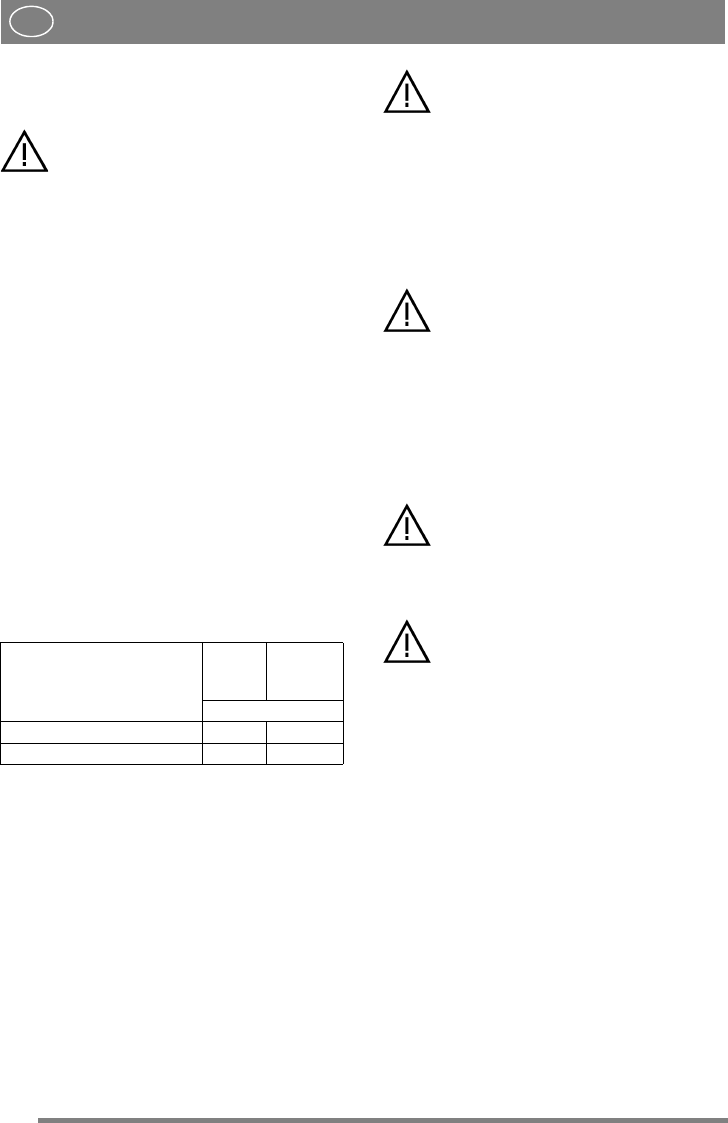
16
ENGLISH
EN
Do not fill with too much oil. This can cause the
engine to overheat.
Change oil when the engine is warm.
The engine oil may be very hot if it is
drained off directly after the engine is
shut off. Therefore allow the engine to
cool a few minutes before draining the
oil.
1. Attach the clamp on the oil drainage hose. Use
a polygrip or similar. See fig. (21:V).
2. Move the clamp up 3-4 cm on the oil drainage
hose and pull out the plug.
3. Collect the oil in a collection vessel.
NOTE! Do not spill any oil on the drive belts.
4. Hand in the oil for disposal in accordance with
local provisions.
5. Install the oil drainage plug and move the clamp
back so that it clamps above the plug.
6. Remove the dipstick and fill up with new oil.
Oil volume: 1.4 litres
7. After filling up the oil, start the engine and idle
for 30 seconds.
8. Check to see if there is any oil leakage.
9. Stop the engine. Wait for 30 seconds and then
check the oil level in accordance with 7.2
Checking the engine oil level.
8.5 Transmission, oil (4WD)
The oil in the hydraulic power transmission must
be checked/adjusted and changed at the intervals
given in the table below.
Type of oil: Synthetic oil 5W-50
Oil quantity when changing: approximately 3.5 li-
tres.
8.5.1 Checking - adjusting
Se “7.2 Checking the engine oil level”.
8.5.2 Draining
1. Run the machine at variable speeds for 10-20
minutes to heat up the transmission oil.
2. Position the machine completely horizontally.
3. Pull out both disengagement levers according to
fig. 17.
4. Place one container under the rear axle and one
under the front axle.
5. Open the oil reservoir by removing the cover.
See (20:R).
Only a 3/8” square drive may be used
for the oil plug. Other tools will damage
the plug.
6. Remove the oil plug from the rear axle. Clean
the hole and use a 3/8” square drive. See figure
22.
7. Remove 2 drain plugs from the front axle. Use
a 12 mm socket. Allow the oil in the front axle
and pipes to run out. See fig. 23.
8. Check that the gaskets on the drain plugs of the
front axle are intact. See fig. 23. Reinstall the
plugs. Tightening torque: 15-17 Nm.
The oil plug will be damaged if it is
tightened more to than 5 Nm.
9. Check that the gasket on the oil plug of the rear
axle is intact. See fig. (22:Y). Reinstall in the
rear axle. Tighten the oil plug to 5 Nm.
10.Draw out the oil from the deeper section of the
reservoir using an oil extractor. See fig. 24.
11.Dispose of the oil according to local regula-
tions.
8.5.3 Filling
The engine must never be run when the
rear clutch release lever is pushed in
and the front clutch release lever is
pulled out.
This will damage the front axle seals.
1.Fill the oil reservoir with the new oil.
If the engine is run indoors, exhaust ex-
traction equipment must be connected
to the engine’s exhaust pipe.
2. Check that the rear axle’s clutch release lever is
pulled out.
3. Start the engine. When the engine is started, the
front axle’s clutch release lever slides inwards
automatically.
4. Pull out the front axle’s clutch release lever.
NOTE! The oil is drawn into the system very
quickly. The reservoir must always be
topped up. Air must never be drawn in.
5. Set the accelerator pedal to the forward position
by blocking it using a wooden wedge. See fig.
25. Fill the oil reservoir by hand using new oil.
6. Run in the forward position for one minute.
7. Move the wooden wedge and set the accelerator
pedal to the reverse position. Continue filling
with oil.
8. Run in reverse mode for one minute.
9. Change driving direction once every minute as
above and continue filling with oil until the
bubbling in the reservoir stops.
10.Switch off the engine, install the oil reservoir
cover and close the engine cover.
11.Test drive for several minutes and adjust the oil
level in the reservoir.
Action
1st time Then at
intervals
of
Hours of operation
Checking – adjusting level. - 50
Changing the oil. 50 200


















